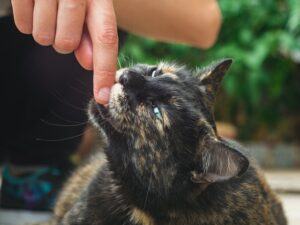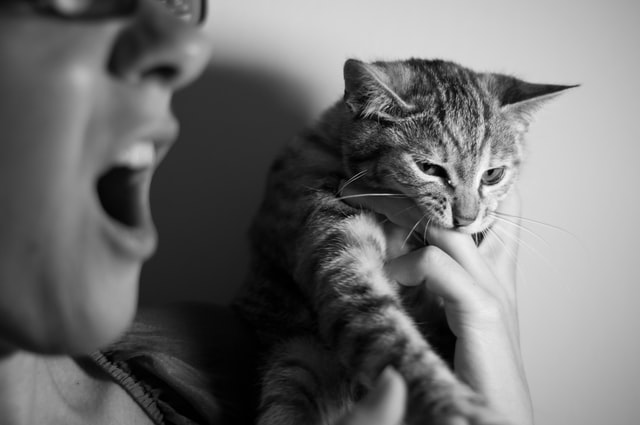“Mio bit me again. What can we do about that?”

If you have a cat, you have likely been bitten at least once. Many pet owners don’t think twice about these bites unless they actively train their pets not to bite.
Most cat bites are playful or affectionate and can even be seen as cute.
Unfortunately, some bites can cause injury and even trigger severe reactions in those with cat allergies. If you do not discourage your cat from biting; they will think it’s okay to bite other people as well.
In this article, I will be showing you how you can train your cat to stop biting.
What is the Problem with Cats & Why do they Bite?
According to Wikipedia:
Data from the United States show that cat bites represent between 5-15% of all animal bites inflicted to humans,[3][4] but it has been argued that this figure could be the consequence of under-reporting as bites made by Felis catus are considered by some to be unimportant.
Studies also show that up to 50% of cat bites can become infected. To read more about the severity of cat bite infections check out Pet Poison Helpline.

There are many reasons why a cat may bite. These can include:
- Affection
- As part of play
- Overstimulation from too much petting in sensitive areas
- Exploration of their environment
- Boredom or trying to get your attention
- Establishing dominance
- Guarding territory or resources
- Fear and anxiety
No matter what the reason is that your cat is biting, it would be best if you didn’t take it too personally. It is not likely that you’re cat is biting you out of spite or revenge. It is more likely your cat is biting you due to overstimulation or a desire to play.
There are ways around this kind of behavior, routines that you can have to prevent your cat from biting, and ways to train your cat not to bite.
In the following sections, I’ll show you how you can train your cat to stop biting.
Training Techniques for Training Your Cat Not to Bite
As I’ve mentioned in previous articles about other forms of training for your cat, patience, and consistency are needed. Treats are also a necessity. However, cat toys are just as crucial in this type of training.
Some toys to consider would be kicker toys or teaser toys such as a feather wand.
A routine that you should have established with your cat would be regular playtime. Playtime can help your cat to burn through some of its natural energy and prevent boredom.
What you should not do when training your cat not to bite:
Never use your hands when playing with your cat, as you will only encourage them to bite more, and they start to see your hands as prey or toys.
When training your cat not to bite, you should never use a spray bottle or any kind of technique that will elicit fear in your cat. Any violence or fear tactic will only cause other unwanted behavior and prevent your cat from trusting you in the future.
What you should do when training your cat not to bite:
Positive reinforcement using treats and toys alongside a firm “No” when the cat bites are all you need.
Using a clicker in this type of training, as mentioned in my article about clicker training, can also be helpful.
When you notice your cat biting firmly, tell them no and use a toy to distract them. When your cat plays with the toy, give them a treat and tap your clicker if you’re using one. With these steps, you will help your cat see that biting you is negative and will start associating toys with prey.

How To Prevent A Cat From Biting
If you are petting your cat and they bite you, you are likely touching a sensitive or over-stimulating spot. Immediately stop touching that area and pet an area on their face or body that is less than stimulating, such as the cheek, face, or neck. If your cat tries to bite you again, immediately stop petting them and provide them with a toy instead.
If your cat is biting out of dominance or resource guarding, it may be best to provide them with an area to eat, sleep or use a litter box separate from other cats or animals in your home. Doing this can be very important to some cats, especially those who have had to fight for resources, such as previously feral cats or cats who come from homes where overcrowding was common.
If you have an anxious cat or show signs of stress but fear, you could try using a room diffuser with a pheromone spray such as Feliway. This natural spray helps calm your cat by mimicking facial pheromones produced by a cat when they are relaxed.
Training your cat not to bite
Biting may be natural for your cat to protect territory, defend itself and its resources, or play. However, this doesn’t mean that biting needs to be acceptable behavior. By being aware of your actions when playing with your cat and petting them, you can avoid unnecessary biting.
Using positive reinforcement with treats and toys, you can teach your cat to associate fighting with pray only and prevent your cat from seeing your hand or ankles as pray.
Calming sprays, reserved spaces, and extra resources for high anxiety cats will also be great tools for you to utilize.
These tips will help your cat feel safe, comfortable, and relaxed. They will also allow you to feel confident bringing strangers into your home, knowing your cats will not injure them.
If you have any questions about or experience with how you can train your cat to stop biting leave your comments below. We can’t wait to hear from Mew!


